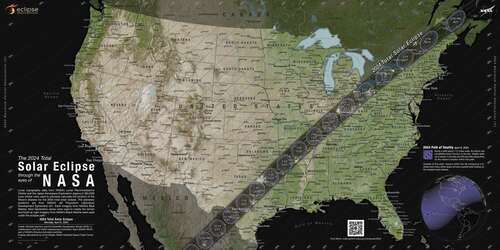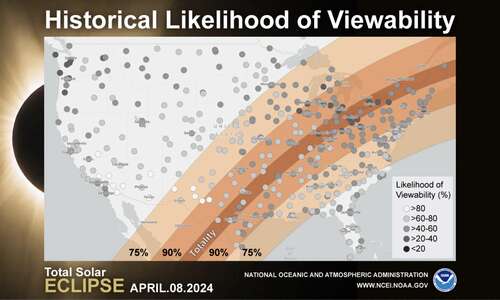Every total solar eclipse is astonishing — if you can see it.
The looming eclipse on April 8, 2024, will allow tens of millions of Americans in the path of totality the opportunity to see the moon completely block the sun and reveal our star’s eerie atmosphere. Overcast or cloudy skies, however, may block some people’s celestial view.
That’s why eclipse chasers often travel to regions that typically experience clear skies and dry weather during such a special event. It gives them better odds of experiencing a rare type of eclipse. But, still, you never know. Weather is weather.
“Climate is what you expect. Weather is what you get,” Richard Fienberg, an astronomer and senior advisor at the American Astronomical Society, told Mashable.
The coming path of the total solar eclipse, shown in the map below, traverses a wide swathe of the U.S. So, indeed, there are places that provide statistically better chances to view the much-anticipated space event.
“Climate is what you expect. Weather is what you get.”
Here’s what you need to know about weather expectations for the coming eclipse — and how different types of weather can affect the experience.

The path of the total solar eclipse on April 8, 2024.
Credit: NASA Science Visualization Studio
The best places to view the solar eclipse
The best odds of experiencing clear skies or few clouds in early April are in relatively western U.S. regions, compared to the Midwest and Northeast. (Though, as explained below, easterly areas aren’t nearly “bad” places to try and see it.)
“Texas and Arkansas are more likely, statistically speaking, to have clear skies on April 8,” Fienberg, who will be venturing to Mexico to experience his 15th eclipse, said.
“For people who are really dedicated to see it, try and go West,” agreed Jack Singal, an astrophysicist at the University of Richmond.
The proof is in the pudding. The National Oceanic and Atmospheric Administration has created a nationwide 2024 eclipse cloudiness map that shows the “historical likelihood of visibility” in many locations, based on long-term climate records.

A zoomed-out view of NOAA’s 2024 total solar eclipse viewability map.
Credit: NOAA / NCEI
Using NOAA’s viewability map is easy. Just type your location (such as “Burlington, VT”) and the map will immediately zoom into that area. Click on the nearest grey or dark circle (this may require zooming out). That will give you cloudiness statistics. For example, on April 8, Burlington, Vermont, is overcast 36 percent of the time, and is mostly cloudy about 17 percent of the time. It’s largely clear about 20 percent of the time. Conversely, the much drier Del Rio, Texas, is clear 64 percent of the time.
Mashable Light Speed
(What’s more, some National Weather Service Offices are providing local cloudiness statistics on their respective websites, too. You might check for eclipse information on your local weather service office’s site.)
But, crucially, notoriously overcast areas can be perfectly clear on April 8. I live in Vermont, which, statistically speaking, isn’t great for April 8 eclipse-viewing. Yet, last year on April 8, the skies were almost perfectly clear in the afternoon, around eclipse time:
“This past April, it was beautiful on April 8,” noted Fienberg, in reference to New England weather in 2023.
“It’s a roll of the dice.”
So there are no guarantees nor sure outcomes.
“It’s a roll of the dice,” noted Singal. “But you’re more likely to win in central and south Texas than you are in Vermont.”
Us Vermonters will keep our fingers crossed.
What if it’s cloudy during the eclipse?
If you’re in the path of totality — a band about 115 miles across where you can see the moon totally blocking the sun — you’ll still likely experience some environmental changes.
“Even if it’s cloudy or raining, it will suddenly get dark in the middle of the day,” Fienberg explained.
That, in itself, is a poignant part of the eclipse-viewing experience.
For many people, some clouds, or passing clouds, are inevitable. But amid gaps in the clouds you should be able to see — with approved eclipse-viewing glasses — the moon gradually moving in front of the sun. While the band of totality is relatively thin, everyone in the Lower 48 states will have the opportunity to at least see a partial solar eclipse (wherein the moon partially blocks the sun) — weather permitting, of course.
We’ll all soon see how large-scale weather patterns impact regional eclipse-viewing on April 8. If you’re in a place that has lower odds of viewing clear skies, like me, the worst that can happen is you gather with friends, families, or neighbors to potentially experience a poignant, if not life-altering, experience.
And if you live in the path of totality, you’re already getting an excellent roll of the dice. A total solar eclipse only hits a particular swathe of Earth around every 375 years, NASA explains.
“If you’re in the path of the eclipse, consider yourself really fortunate,” Fienberg said.

